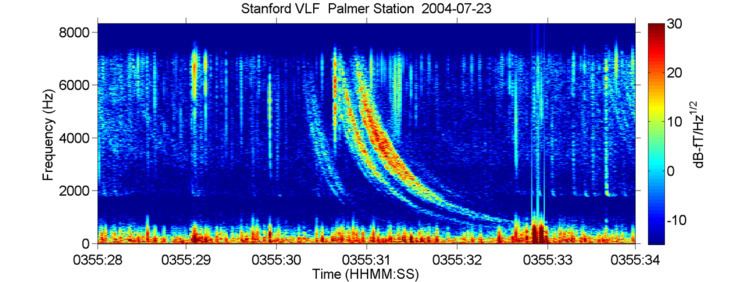 | ||
A whistler is a very low frequency or VLF electromagnetic (radio) wave generated by lightning. Frequencies of terrestrial whistlers are 1 kHz to 30 kHz, with a maximum amplitude usually at 3 kHz to 5 kHz. Although they are electromagnetic waves, they occur at audio frequencies, and can be converted to audio using a suitable receiver. They are produced by lightning strokes (mostly intracloud and return-path) where the impulse travels along the Earth's magnetic field lines from one hemisphere to the other. They undergo dispersion of several kHz due to the slower velocity of the lower frequencies through the plasma environments of the ionosphere and magnetosphere. Thus they are perceived as a descending tone which can last for a few seconds. The study of whistlers categorizes them into Pure Note, Diffuse, 2-Hop, and Echo Train types.
Contents
Voyager 1 and 2 spacecraft detected whistler-like activity in the vicinity of Jupiter, implying the presence of lightning there.
History
Whistlers were probably heard as early as 1886 on long telephone lines, but the clearest early description was by Barkhausen in 1919. In 1953, Storey showed that whistlers originate from lightning discharges.
Nomenclature
A type of electromagnetic signal propagating in the Earth–ionosphere waveguide, known as a radio atmospheric signal or sferic, may escape the ionosphere and propagate outward into the magnetosphere. The signal is prone to bounce-mode propagation, reflecting back and forth on opposite sides of the planet until totally attenuated. To clarify which part of this hop pattern the signal is in, it is specified by a number, indicating the portion of the bounce path it is currently on. On its first upward path, it is known as a 0+. After passing the geomagnetic equator, it is referred to as a 1−. The + or - sign indicates either upward or downward propagation, respectively. The numeral represents the half-bounce currently in progress. The reflected signal is redesignated 1+, until passing the geomagnetic equator again; then it is called 2−, and so on.
Finding of whistlers
Whistlers were first detected during World War 1. On the wide-band spectrogram, the observed characteristic of a whistler is that the tone rapidly descends over a few seconds. This is the origin of the name "whistlers".
The first spectrogram through which people heard the whistlers was taken from a 48 second long nightside plasmaspheric pass on March 26, 1996. These whistlers were seen at a frequency below 1.5 kHz.
